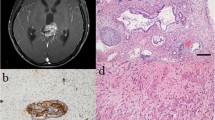Abstract
Purpose
About 5 % of pediatric intracranial germ cell tumors and 20 % of non-germinomatous germ cell tumors (NGGCT) progress to growing teratoma syndrome (GTS) following chemoradiotherapy. The growing teratoma is thought to arise from the chemotherapy-resistant, teratomatous portion of a germ cell tumor and is commonly benign but may undergo malignant transformation.
Methods
Two pediatric patients whose intracranial NGGCTs progressed to growing teratomas during chemotherapy and later transformed to secondary malignant tumors after partial resection and radiation therapy (RT).
Results
Both tumors were diagnosed by MRI scans and elevated serum and CSF markers. Following normalization of tumor markers with chemotherapy and initial decrease in tumor volume, subsequent imaging showed regrowth during chemotherapy with pathology revealing benign teratoma. RT was administered. Several years following this treatment, further growth was seen with pathology indicating malignant carcinoma in one patient and malignant rhabdomyosarcoma in the other. The patient with carcinoma received palliative care while the patient with the sarcoma received further resection, intensive chemotherapy, and an autologous stem cell transplant and is currently in remission, 36 months since malignant transformation.
Conclusion
Malignant transformation of presumed residual teratoma has been seldom reported. Treatment of NGGCT involves platinum-based chemotherapy with craniospinal RT and boost to the primary site, with cure rates of around 80 %. Teratomas are characteristically chemotherapy and RT resistant and are treated surgically. In the event that residual or growing teratoma is suspected, a complete resection should be considered early in the management as there is a risk of malignant transformation of residual teratoma.


Similar content being viewed by others
References
Aliotta PJ, Castillo J, Englander LS, Nseyo UO, Huben RP (1988) Primary mediastinal germ cell tumors: histologic patterns of treatment failures at autopsy. Cancer 62:982–984
Echevarría ME, Fangusaro J, Goldman S (2008) Pediatric central nervous system germ cell tumors: a review. Oncologist 13:690
Fangusaro J, Finlay J, Sposto R, Ji L, Saly M, Zacharoulis S, Asgharzadeh S, Abromowitch M, Olshefski R, Halpern S, Dubowy R, Comito M, Diez B, Kellie S, Hukin J, Rosenblum M, Dunkel I, Miller DC, Allen J, Gardner S (2008) Intensive chemotherapy followed by consolidative myeloablative chemotherapy with autologous hematopoietic cell rescue (AuHCR) in young children with newly diagnosed supratentorial primitive neuroectodermal tumors (sPNETs): report of head start I and II experience. Pediatr Blood Cancer 50:312–318
Freilich RJ, Thompson SJ, Rosemblum MK (1995) Adenocarcinomatous transformation of intracranial germ cell tumors. American Journal of Surgical Pathology 19(5):537–544
Goodwin TL, Sainani K, Fisher PG (2009) Incidence patterns of central nervous system germ cell tumors—a SEER Study. J Pediatric Hematology Oncology 31:541–544
Greenberg JO (1995) Neuroimaging—principles of neurology. McGraw-Hill. New York. pages 360–361
Kamitani H, Miyata H, Ishibashi M, Kurosaki M, Mizushima M, Akatsuka K, Ohama E, Watanabe T (2006) Mixed germ cell tumors with abundant sarcomatous component in the temporal lobe after radiochemotherapy of neurohypophyseal germinoma: a case report. Brain Tumor Pathology 23:83–89
Kim CY, Choi JW, Lee JY, Kim SK, Wang KC, Park SY, Choe G, Ahn HS, Kim IH, Cho BK (2011) Intracranial growing teratoma syndrome: clinical characteristics and treatment strategy. J Neurooncol 101:109–115
Kong DS, Nam DH, Lee JI, Park K, Kim JH, Shin HJ (2009) Intracranial growing teratoma syndrome mimicking tumor relapse: a diagnostic dilemma. J Neurosurg Pediatrics 3:392–396
Logothetis CJ, Samuels MD, Trindade A, Johnson DE (1982) The growing teratoma syndrome. Cancer 50:1629–1635
Moiyadi A, Jalali R, Kane SV (2010) Intracranial growing teratoma syndrome following radiotherapy—an unusually fulminant course. Acta Neurochir 152:137–142
Nimkin K, Gupta P, McCauley R, Gilchrist BF, Lessin MS (2004) The growing teratoma syndrome. Pediatric Radiology 34:259–262
O'Callaghan AM, Katapodis O, Ellison DW, Theaker JM, Mead GM (1997) The growing teratoma syndrome in a nongerminomatous germ cell tumor of the pineal gland: a case report and review. Cancer 80:942–947
Smith AA, Weng E, Handler M, Foreman NK (2004) Intracranial germ cell tumors: a single institution experience and review of the literature. Journal of Neuro-Oncology 68:153–159
Utsuki S, Oka H, Sagiuchi T, Shimizu S, Suzuki S, Fujii K (2007) Malignant transformation of intracranial mature teratoma to yolk sac tumor after late relapse. J Neurosurg 106:1067–1069
Conflict of interest
There are no conflicts of interest to disclose.
Author information
Authors and Affiliations
Corresponding author
Additional information
All authors have approved and were included in the final draft of this manuscript.
This study has been approved by our ethics committee and has therefore been performed in accordance with the ethical standards laid down in the 1964 Declaration of Helsinki and its later amendments.
The data collected for this manuscript was presented in poster format at the 2012 Society for Neuro-Oncology meeting as well as the 2012 BC Cancer Agency annual meeting.
Rights and permissions
About this article
Cite this article
Glass, T., Cochrane, D.D., Rassekh, S.R. et al. Growing teratoma syndrome in intracranial non-germinomatous germ cell tumors (iNGGCTs): a risk for secondary malignant transformation—a report of two cases. Childs Nerv Syst 30, 953–957 (2014). https://doi.org/10.1007/s00381-013-2295-1
Received:
Accepted:
Published:
Issue Date:
DOI: https://doi.org/10.1007/s00381-013-2295-1




